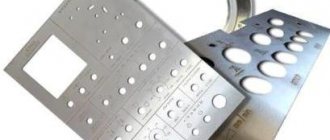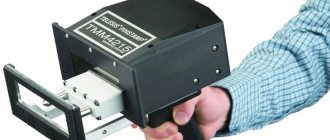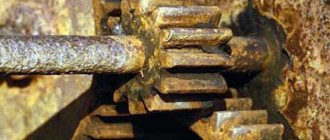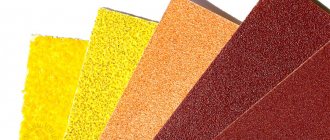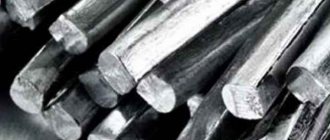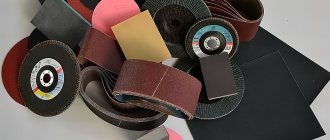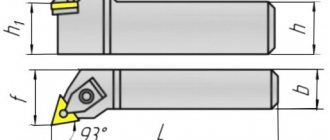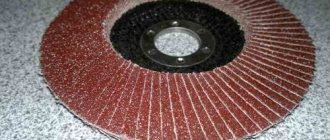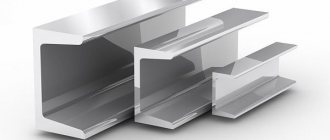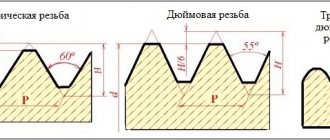To order tools and technical consultations, place an order on our website. Our staff will promptly contact you. You can send your applications and questions by email [email protected] or call (495) 668-13-58. You can also use the application form on the website.
specializes in the design and supply of equipment for marking products of metallurgical plants.
Our engineers develop and implement specialized integrated solutions in metallurgy for marking both cold and hot metal.
Automated and automated systems allow for branding and marking of the following types of products: pipes, sheets, rolled products, coils, slabs, pigs, etc.
Our specialists also implement product identification and traceability systems throughout the entire production cycle of products, including the ability to transfer and use data at subsequent stages (storage, operation, etc.).
When designing systems, we use equipment from the world's leading manufacturers, which is optimally suited to the tasks of our Customers in each specific case.
Our engineers design and implement the following types of industrial marking solutions on cold and hot metal:
• Impact-mechanical marking and marking by drawing (using stamping)
• Marking with paint or ink
• Spray marking
• Laser marking
• Marking with plates (tags)
All solutions have the ability to program the composition of the brand, the ability to select font types and sizes using built-in control systems, and are also easily integrated with factory automated process control systems (APCS) - conveyor line control systems, etc.
Industrial markings in metallurgy are common and in many cases mandatory. Depending on the material on which the marking is applied and the requirements imposed by standards, technical specifications and customers, it is possible to use different types of marking of pipes, rolled products, sheets, coils, pigs, slabs, etc. Accordingly, different equipment is used to apply different types of markings .
Concept of labeling
Marking is the application of signs characterizing it to a product.
Methods of applying inscriptions on metal
This may include:
- Name,
- options,
- batch number,
- corporate logo,
- quality mark
The inscription should be clear, concise, and durable. Let's look at some ways of applying inscriptions to metal products.
Sets of letter and number stamps for metal.
In industry, there is often a need to apply certain information to surfaces with different properties. The simplest identification method for metal parts and workpieces is impact stamping. The method does not require expensive equipment and allows you to leave an indelible inscription in the form of deep, easily readable indentations: letters, numbers or the manufacturer’s logo. This could be a part identification code according to the assembly drawing, a serial number for maintaining special records, an element of a set of anti-counterfeiting measures, the passage of a released product through quality control, or individualization of the mechanism.
Lettering methods
Branding methods can be different:
- Mechanical
- Chemical
- Electrical
- Photochemical
- Electrochemical
How to choose a labeling method? Usually the designer makes a choice by comparing some product parameters. Namely: product configuration, size, material, surface hardness, production volume, aesthetic requirements, the nature of the marking applied, its constancy, the degree of mechanization and automation of production.
Testing systems
In addition to the convenient and most accurate metric system, gold can be marked with a karat standard. This method of indicating the purity of an alloy is typical for America, Western Europe and some Eastern European countries. A carat is equal to 1/24 of the total mass, that is, 24 carat gold is a substance without impurities, and, for example, 18 carats means that the alloy contains 18 parts of gold out of 24. Common samples: 9, 10, 12, 14, 18 , 22 and 23 carats, the minimum permissible carat fineness is 8 carats. The ratio of carat and metric samples is as follows:
- 999 standard = 24 carats;
- 958 standard = 23 carats;
- 916 standard = 22 carats;
- 750 standard = 18 carats;
- 625 standard = 15 carats;
- 585 standard = 14 carats;
- 500 standard = 12 carats;
- 416 standard = 10 carats;
- 375 standard = 9 carats;
- 333 hallmark = 8 carats.
On products made abroad, for example, the following carat designations are found: 18K, 10Kt, 22CT, 12C. That is, one of the possible carat designations is placed next to the hallmark number in the stamp.
Convert carats to grams
The karat measurement of metals should not be confused with the designation of precious stones.
There the values change, for example, 513 carats corresponds to a stone weighing 102.6 grams, 583 carats - 116.6 grams, 686 carats - 137.2 grams. The metric system determines the value of an alloy based on the gold content of 1 kg of the alloy. The most popular standard is 585, which means that per 1000 grams of alloy there are 585 grams of gold and 415 grams of impurities and other metals.
Since different countries have different systems, sometimes buyers get confused in determining the value of a product when choosing jewelry abroad. Gold hallmarks indicated in carats can be easily translated into understandable Russian numbers: 9 carats means a hallmark of 375 gold, 14 carats means 585, and 24 carats corresponds to the purest gold of 999 purity. For the manufacture of rings, 565 and 575 samples are most often used.
Stamps designate not only products made of gold, but also those made of silver and gilded. For example, a pure silver bar is 999 fine, but this composition is not suitable for making jewelry due to its softness and other physical properties. Household items correspond to hallmark 875, and jewelry - to 925. But gold rings, earrings and chains are not marked with hallmarks 593 and 725. Most likely, you got a fake, and you can determine this fact by contacting a pawnshop or buyers. They will evaluate the product.
Electric spark pencil
Today you can find several names: electric pencil, electric spark pen, electric marker.
Electric spark pencil
Using an electric marker, inscriptions are applied to a smooth metal surface.
This method is chosen in cases where the impact-point method is not suitable, stamps are inconvenient, laser application is too expensive or impractical.
The marking pencil is mainly used for metal components and parts where bulging of the surface due to the marking is not allowed.
It is often used as a means of adjusting and correcting markings on a flat or relatively flat metal surface. The type and alloy of the metal may be different.
What are the methods and devices for marking?
Methods and devices for marking metal are divided into the following types.
Drop jet method. This type of marking is notable for the fact that it does not completely damage the metal surface. Drip-jet markings do not corrode or oxidize. The design is created by applying ink drops.
Laser method. It allows you to easily apply markings to any type of metal: nickel, brass, etc. To apply an image in this way, the product is installed in the device and the parameters of the future marker are set. Application occurs like this: the laser beam moves and burns the outline of the marker to the set depth and width.
Impact dot marking
The impact-point method is used for engraving on products made of soft metals. For example, such as brass, bronze, fittings. You can also order markings on metal for some piece products.
It is recommended to use for metal assembly units (assemblies) and parts, except thin-walled ones.
Impact dot marking
- With this equipment you can apply markings to any surface.
- This method is often used in the production of pipes and other metal structures.
- The main advantage of this method is the high speed of operation and the absence of consumables.
- The markings are clear. Has high resistance and durability.
Marking is a necessary element in any industry
Today, markings are used everywhere. They are used on various types of industrial equipment and tools. Marking is needed because it is a kind of code that tells about the composition of the metal and its quality. Marking is an alphanumeric designation applied to any part of the metal surface.
Metal markings can be of two types:
The first type is an informative marker.
The second type is identification
In order for the marking to be durable and of high quality, it must be applied only with professional equipment, which is selected individually for each metal. Smart Marking company offers a wide range of marking equipment at affordable prices and manufactured to all standards.
Laser marking
This marking method is represented by various devices. The following markers are possible:
- Gas laser
- Solid State
- Fiber optic markers for metal and plastic
- Lasers for delicate marking of electronics
- Ultraviolet for products in instrument making
- Double-headed devices for double efficiency
Many large enterprises in mechanical engineering, aircraft manufacturing, and instrument making give preference to this particular marking method.
Stamps
For more accurate and convenient marking, stacked impact stamps are used. The necessary letters are inserted into the holder (punch), and the desired digital string is obtained. The line turns out smooth and uniform in depth. It is mainly used for marking relatively static data; it is inconvenient to enter serial numbers with such a device.
The kit includes Russian or Latin letters and numbers, special symbols required by the customer, etc.
Many self-respecting craftsmen, both in our time and in distant history, made homemade tools for their work. Previously, of course, it was not easy to get the necessary tools and even buy them, but today it would seem that there is nothing in specialized stores, and craftsmen still make their own tools, because it is cheap and simple.
Electrochemical methods of marking on metal
Along with mechanical marking, electrochemical marking is also used - this is a technology for applying images, logos, alphanumeric information using electric current and acid.
Electrochemical marking
The operating principle is as follows. The power supply supplies electric current to the part through the electrode. The current, passing through the material soaked in the electrolyte and a special dielectric stencil for marking, leaves an etched mark in an empty space. It is necessary to ensure that the stencil fits tightly to the surface of the part to be marked.
The electrolyte for electrochemical marking is a saline solution that speeds up the process of transferring charged electrons between potentials.
The effective voltage for the etching reaction to occur is from 3 to 15 V. The peculiarity of this method of marking metal is that the boundaries are somewhat fuzzy. Therefore, the logo and details on it should be large enough.
Branding methods
Hallmarking is an assay-technological operation of applying an imprint of the state hallmark on jewelry and household items made of precious metals.
1.
Mechanical method - stamp impressions are applied to the product using the impact method (mechanical hallmarks using a hammer, or on machines for mass stamping).
Imprints are applied both inside and outside. Special stands are also used - anvils that match the shape of the product. It is the most widespread method (70-80% of all products are branded this way). ADVANTAGES: Prints are clear, stable, durable. DISADVANTAGES: When applying stamps, the product may be subject to damage (some deformation from hitting the stamp with a hammer).
2.
Electro-spark method - stamp imprints are applied to the product with copper electrode stamps using an electric-spark installation.
The print is burned with a spark running along the contour of the electrode stamp in an aqueous environment under the influence of an electric current. A distinctive feature of the nameplate for electric spark branding should be the jumpers at the top between the outline of the nameplate and its signs, as well as the entry of the electrode in front from the top. 10-20% of jewelry is branded using this method (approximately 400 items per shift).
ADVANTAGES: Prints are clear, stable, durable. Products are not damaged. Possibility of application to specific shapes, as well as hollow ones, etc. products. DISADVANTAGES: The only caveat is the need for more thorough preparation of the area for the sample impression. The slightest pores, roughness, casting defects or insufficient polishing - and the electric spark method is no longer applicable.
3.
Laser method - carried out using a laser machine.
In this case, mask stamps are used. The outline of the mark is dotted. The surface must be carefully prepared and polished. 10-20% of jewelry is branded using this method (approximately 600 items per shift). ADVANTAGES: Prints are clear. Possibility of application to any surface (convex, concave, hollow). DISADVANTAGES: None, except for careful surface preparation.
Decoding of the name
1 - year code 2 - code of the State Inspectorate of Assay Supervision, in the area of operation of which the manufacturer is located 3 - manufacturer code
breakdown by year: A - 2001, B - 2002, C - 2003, D - 2004, D - 2005, E - 2006, C - 2007, I - 2008
- the second indicates the inspection of the assay office: L - North-Western (no change)
| Assay inspections | Location | Codes on stamps |
| 1. Verkhne-Volzhskaya | r/p Krasnoe-on-Volge, Kostroma region. | IN |
| 2. Volgo-Vyatka | Nizhny Novgorod | G |
| 3. East Siberian | Krasnoyarsk | I |
| 4. Far Eastern | Khabarovsk | YU |
| 5. Donskaya | Rostov-on-Don | TO |
| 6. Western | village Yantarny, Kalaningrad region. | F |
| 7. Transbaikal | Ulan-Ude | AND |
| 8. West Siberian | Novosibirsk city | N |
| 9. Povolzhskaya | Ufa | P |
| 10. Podmoskovnaya | Bronnitsy, Moscow region. | B |
| 11. Prikaspiyskaya | Makhachkala | Z |
| 12. Sakha | Yakutsk | D |
| 13. North | Veliky Ustyug, Vologda region. | A |
| 14. North-West | Saint Petersburg | L |
| 15. Ural | Yekaterinburg city | WITH |
| 16. Central | Moscow | M |
— the last characters identify the manufacturer (without change)
As you can see, by the name and assay mark you can really find out what any product intended for sale in Russia is.
Types and forms of brands
Precious jewelry is marked not only with gold hallmark numbers. All products must be branded. The applied mark may have a different shape, depending on the country of origin and the designation system adopted there.
In Russia, two types of printing are most often found:
- image of a female profile facing the right side;
- a hammer and sickle located on a five-pointed star.
Regardless of the shape and type, the mark must contain mandatory information: the code of the service that applied the seal, the marking of the content of precious metal in the alloy used and the symbol of the assay service’s identification.
The cost of products is directly proportional to the percentage of precious metal. It is almost impossible for a simple buyer who has no experience working with jewelry to determine the authenticity of the applied mark. Often very good and high-quality fakes with 585 or even 750 purity are passed off as real gold. In fact, scammers have learned to illegally apply samples and deceive consumers. To check whether the value of the mark corresponds to the true content of the precious metal, a visual inspection with magnifying devices and additional testing procedures will be required.
The surface of the gold object is first cleaned, then passed over the surface of a special stone. There should be gold stripes left on it, onto which you need to apply reagents. If the sample is high, then the remaining strokes will not disappear and will not even change color. If the strips have completely dissolved, it means that the product is of low quality or does not contain yellow metal at all. At home, it is extremely difficult to determine the quality of products , and it is not even always clear whether it is gold or silver. The 325th standard is the lowest that is allowed in jewelry production; it may outwardly look like a gold-plated silver product.
325 gold items are in demand and highly valued in England and some other countries. In Russia, this metal is considered low-grade. Separately, we can highlight jewelry with the designation 588. They are made of a high-quality alloy, including 11 parts of yellow metal and 1 part of elite platinum. The cost of such goods is much higher. Elite items also include items marked 983; their price can be extremely high due to the use of noble red gold.
How to determine gold purity by the color of the alloy
The color of pure gold is bright yellow, but due to its softness, this metal in its pure form is not used to create jewelry. Jewelry is made from gold alloys, in which only part of the composition is allocated to gold. Ligatures (additives) make the connection harder, stronger, and give it different shades.
Based on the shade of the alloy from which the product is made, one can assume its sample. But this method of determining the composition is imperfect; only examination can accurately determine the percentage of gold and other metals.
Pink
This shade is characteristic of alloys containing silver and copper, in particular the following samples:
- 375: dark pink,
- 585: soft pink;
- 750: slightly pinkish.
White
If you see a piece of jewelry with a white tint, most likely it is 750-grade metal. 25% of the composition is occupied by silver and palladium or silver and nickel.
Green
- Dark green color is typical for 750 standard with the following composition: 75% gold, 15% silver, 6% copper, 4% cadmium.
- The pale green material is obtained when 23% copper and 2% cadmium are added to 75% gold.
- The yellow-green metal is most likely 750 fine, and 25% of the composition is silver.
Violet
Gold jewelry may have a purple tint if it is made from a 14-karat alloy that contains 25% aluminum or potassium. If the color is rather bluish, then with a high probability it is a composition of 46% noble metal and 54% rhodium, cobalt or indium.
Sources
- https://lombardyinfo.ru/stati/probirnoe-klejmo.html
- https://ZolotoMan.ru/proby/klejmo-na-zolote.html
- https://ToZoloto.ru/proba/klejmo-na-zolote.html
- https://zolotogid.ru/metally/sistema-oboznacheniya-proby-na-zolotyh-izdeliyah-i-pozolote/
- https://uvelir.info/articles/probirovanie-yuvelirnyih-izdelij-eto-dolzhen-znat-kazhdyij-probyi-klejma-imenniki/
- https://goldomania.ru/articles-2/hallmark_gold.html
- https://russam.ru/stati/o_juvelirnyh_izdelijah/p18881-kakie_byvajut_proby_zolota/
